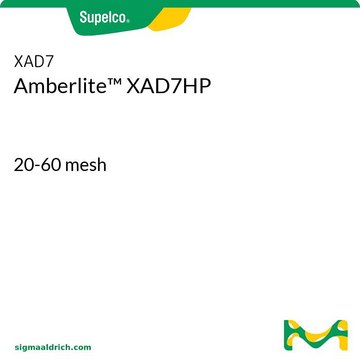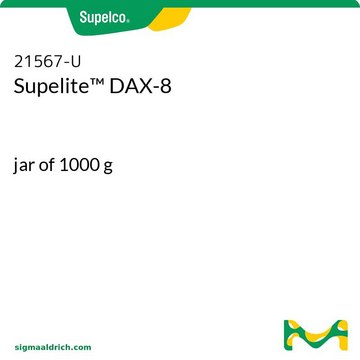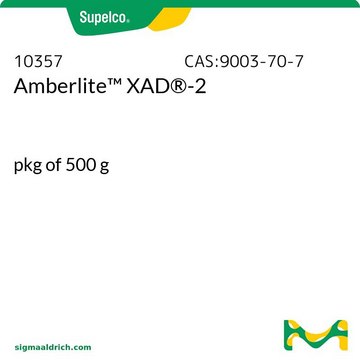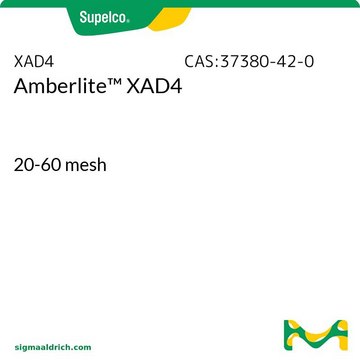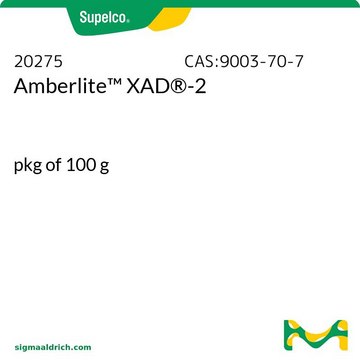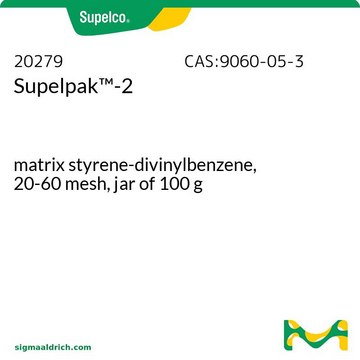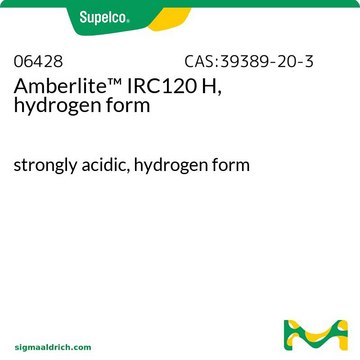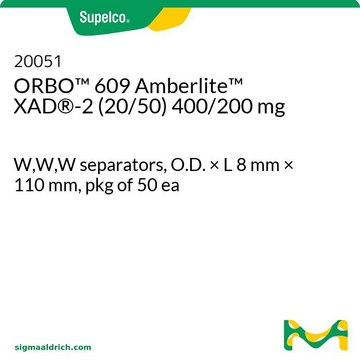Recommended Products
form
solid
packaging
jar of 100 g
technique(s)
HPLC: suitable
LPLC: suitable
ion chromatography: suitable
surface area
140 m2/g
matrix
acrylic ester
matrix active group
polymer
particle size
40-60 mesh
pore size
~0.79 mL/g pore volume
225 Å mean pore size
density
1.09 g/mL at 25 °C (true wet)(lit.)
1.23 g/mL at 25 °C (skeletal)(lit.)
separation technique
reversed phase
Looking for similar products? Visit Product Comparison Guide
General description
Application
- HPLC-SEC fractionation system
- column chromatography
- extraction procedure and extracts were analysed using Cary Eclipse fluorescence spectrophotometer
Preparation Note
- First, rinse the adsorbent resin with 2-3 bed volumes (BV) of distilled water.
- Soak overnight in 2 BV of 95% ethanol.
- After soaking, the resin is introduced into the column and rinsed with an additional 2 BV of 95% ethanol.
- Rinse with 2 BV of distilled water to displace the ethanol, followed by 1 BV of 4% (w/v) sodium hydroxide, 2 BV of distilled water, 1 BV 4% (v/v) hydrochloric acid, and finally by distilled water until the pH of the eluent becomes neutral.
Legal Information
Storage Class Code
11 - Combustible Solids
WGK
WGK 3
Flash Point(F)
Not applicable
Flash Point(C)
Not applicable
Personal Protective Equipment
Choose from one of the most recent versions:
Already Own This Product?
Find documentation for the products that you have recently purchased in the Document Library.
Which document(s) contains shelf-life or expiration date information for a given product?
If available for a given product, the recommended re-test date or the expiration date can be found on the Certificate of Analysis.
How do I get lot-specific information or a Certificate of Analysis?
The lot specific COA document can be found by entering the lot number above under the "Documents" section.
How do I find price and availability?
There are several ways to find pricing and availability for our products. Once you log onto our website, you will find the price and availability displayed on the product detail page. You can contact any of our Customer Sales and Service offices to receive a quote. USA customers: 1-800-325-3010 or view local office numbers.
What is the Department of Transportation shipping information for this product?
Transportation information can be found in Section 14 of the product's (M)SDS.To access the shipping information for this material, use the link on the product detail page for the product.
My question is not addressed here, how can I contact Technical Service for assistance?
Ask a Scientist here.
Our team of scientists has experience in all areas of research including Life Science, Material Science, Chemical Synthesis, Chromatography, Analytical and many others.
Contact Technical Service